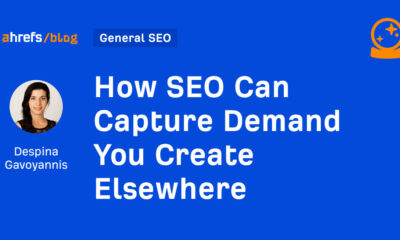“What we’ve noticed over the years is that there is a gap in many demand gen machines,” said Shachar Radin Shomrat, CMO of Deepcrawl, in her presentation at The MarTech Conference. “In some, a whole piece is completely missing. In others, it exists, but is underperforming.”
The single most important challenge growth marketers face, according to Shomrat, is allocating resources across the many marketing activities they engage in. Marketers call this the “demand gen problem.”

One of the ways marketers address this issue is by employing demand generation machines, which are systems set up to help brands optimize demand processes. And although these tools address demand generation well most of the time, many marketers fail to optimize them effectively.
Shomrat believes one of the main causes of these issues is marketers’ underprioritization of organic channels.
“More often than not, marketers are putting the bulk of their earning energy and spend into paid digital acquisition channels,” she said. “The problem, however, is that those are expensive channels that drive up the cost of customer acquisition and over time will provide diminishing returns.”

“It’s time for marketers to prioritize organic channels,” she added.
Embracing the benefits of an optimized technical structure
When most brands think of organic marketing, they tend only to consider keywords, off-site links, and content elements. Unfortunately, this neglects one of the foundational pieces of website health: the technical structure.
“The technical foundations are critical for the website performance in search,” Shomrat said. “In general, they are typically deprioritized at best or completely overlooked.”
She added, “Today, succeeding in organic search is about a lot more than just keywords and content — it demands technically sound websites.”
The key to a healthy technical site foundation, according to Shomrat, is efficient resource allocation. Rather than focusing primarily on short-term, costly boosts with paid channels, growth-minded marketers must allot more resources to technical elements that can help grow organic visibility.
Here are some of the key areas where marketers can allocate resources to improve their sites’ technical soundness and help extend their organic reach.
Architecture
An optimized site architecture lays out pages so search engines and users can easily understand where each piece of content is found. This helps increase engagement.
Availability and crawlability
Your site pages need to be accessible to search engines and users via valid HTTP status codes. This allows for crawling, which is the process in which search engines assess your page content.
Site owners should make sure the pages they want to be included in search engines have a 200 HTTP status code, which signals that the page exists and can be crawled — just so long as it’s not blocked by the site’s robots.txt file.
Indexability
Just because your pages are crawlable doesn’t mean they’re indexable. Marketers need to make sure their pages’ robots tags allow for indexing, and, in turn, ranking in the search results.
Get the daily newsletter digital marketers rely on.
Authoritative, relevant content
“If a page does not appear to be credible or authoritative, then it will [probably] not rank as highly as pages that appear more credible or authoritative in the search engine results,” said Shomrat.
Marketers can build their site authority by creating relevant content that demonstrates expertise in its subject area.
But, no matter how authoritative a page’s content is, it will ultimately fail to connect with audiences if it’s not relevant to their needs.
“If a page does not contain content elements that clearly address a user or a customer’s needs and pain points, then users will not click on the page,” she said.
Experience
People are less likely to convert on sites that offer poor experiences, such as slow-loading pages. Google and other search engines encourage site owners to optimize their technical structures to prevent this from happening, allowing their content to shine in the search results.
“If you do not fix your [technical] foundation, your content and keyword investments are not going to get the return that you expect,” Shomrat said.
What happens when optimizing website health isn’t driving ROI?
“While there are some businesses that overlook their website health, there are others for whom it has always been critical, even before the recent digital acceleration and search ranking algorithm changes,” said Shomrat. “Those are the businesses for whom the website is the product. For example, e-commerce brands, online marketplaces, and global brands with hundreds of local sites.”
“The central truth is that even those growth marketers that understand and acknowledge the value of website health often struggle with getting it right,” she added.
Shomrat says businesses that struggle to maintain technical soundness despite prioritizing website health often face budgetary and resource issues. To address these hold-ups, she recommends marketers work with other operations teams, using their expertise to help improve technical processes.
“The research has clearly shown that website health and organic search suffer from operational challenges,” she said. “To solve them, a cross-functional approach is needed.”

Adopting a cross-functional strategy that spans departments can help eliminate data and operation siloes that contribute to poor website health. Shomrat recommends marketers work to bring these ops teams together to more effectively maintain their site’s structural integrity for the long term.
“Expanding your operational view by thinking of marketing ops as digital ops will help break down those silos and create new, more seamless pathways to [improve] your website health efforts,” she said.
SEO platforms: A snapshot
What is SEO? Search engine optimization encompasses a wide range of marketing activities, including content marketing, user experience strategy, technical analysis, and more, all with the goal of increasing the traffic websites receive from search engines.
What do the tools do? SEO platforms help marketers draw more insights from their work. They offer capabilities such as rank-checking, advanced keyword research, competitive intelligence, and backlink analysis. What’s more, enterprise-level platforms take these functions to new heights with extensive auditing and analysis of page performance, making it easier to find key areas needing improvement.
Why we care. SEO has remained one of the key foundations of digital marketing for years. Search drives roughly 50% of website traffic on average, according to a study on SimilarWeb data by Growth Badger. And while marketers have developed strategies to keep up, SEO’s growing complexity has made this a more complicated marketing discipline that companies cannot afford to ignore.
Read next: What do SEO platforms do and how do they help marketers get found on search engines?















You must be logged in to post a comment Login